Abstract
Occupational asthma among hairdressers has been recognised for some years and cases of work related asthma due to hair bleaches containing persulphates and hair dyes have been reported. The extent of the disease among hairdressers remains unknown. An investigation was carried out on an entire hairdressing salon, which specialised in hair bleaching and colouring and which employed 23 staff. On the basis of history and specific and non-specific bronchial provocation testing, four out of 23 staff were found to have occupational asthma due to the persulphate salts contained in hair bleaches. Only one of these had a positive skinprick test response to persulphate salts. Tests for non-specific bronchial reactivity to histamine in this work force were more sensitive for the diagnosis of asthma than simple lung function tests or recordings of peak flow rates performed four times daily for three weeks. The response to these agents was studied in greater detail by specific bronchial provocation tests in 14 members of the salon as well as one hairdresser from elsewhere with occupational asthma, three individuals with non-occupational asthma, and four normal subjects. Only those with a history of work related asthma and bronchial hyperreactivity responded positively, confirming that the response to bleach powders was specific. Studies of pulmonary mechanics after challenge showed that the response arose from changes in airway calibre not lung volumes. Measurement of neutrophil chemotactic activity after challenge showed significant rises in those affected, suggesting that mast cells may play a part in the pathogenesis of occupational asthma due to persulphates.
Full text
PDF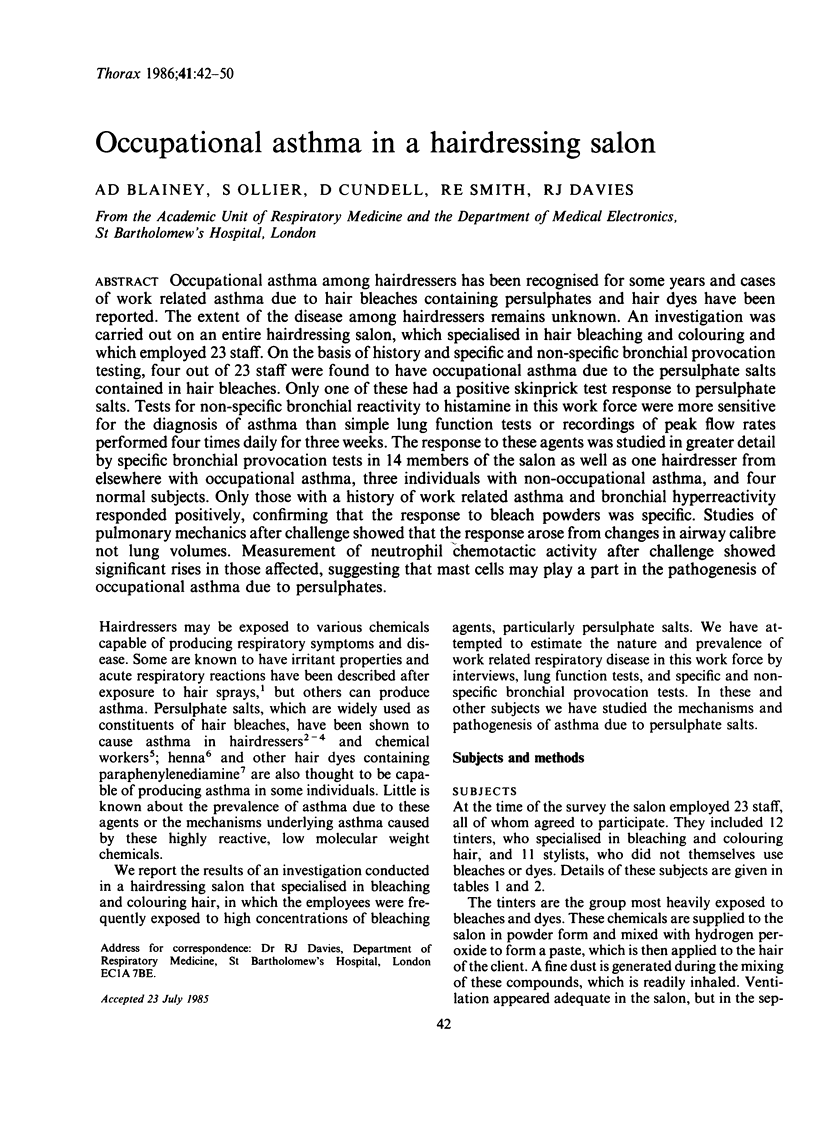

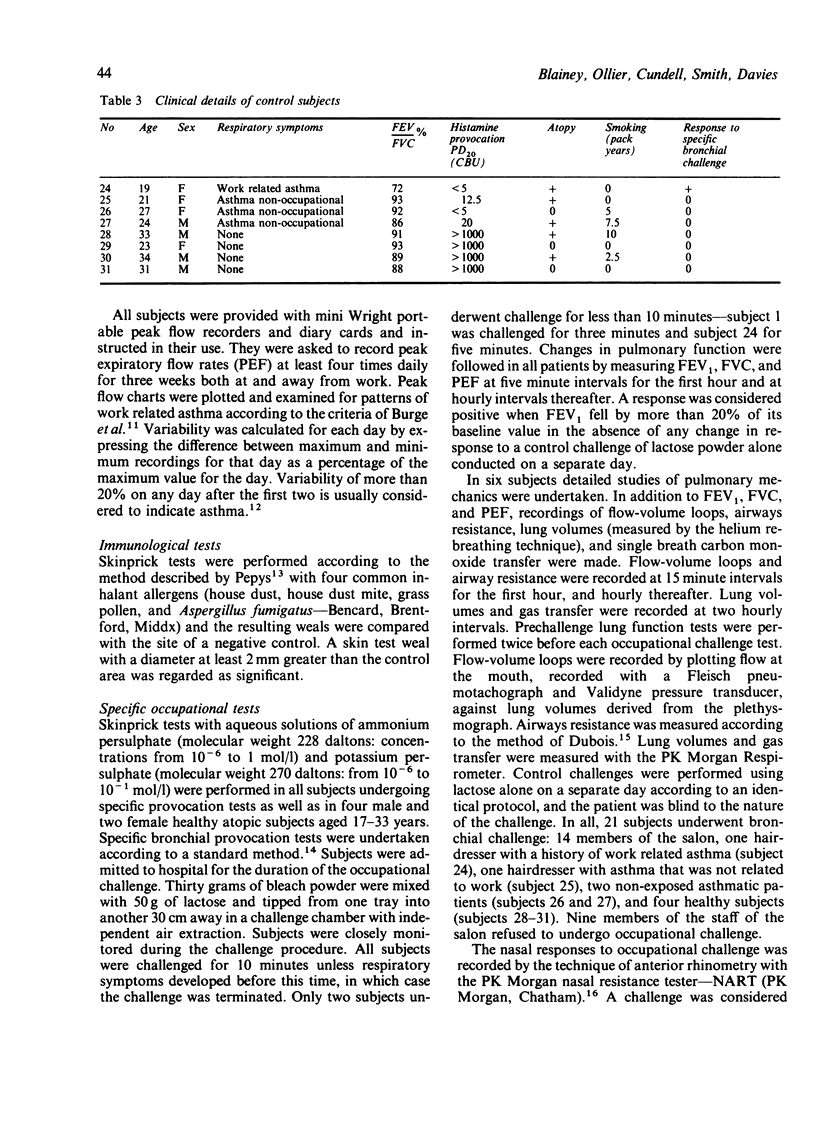
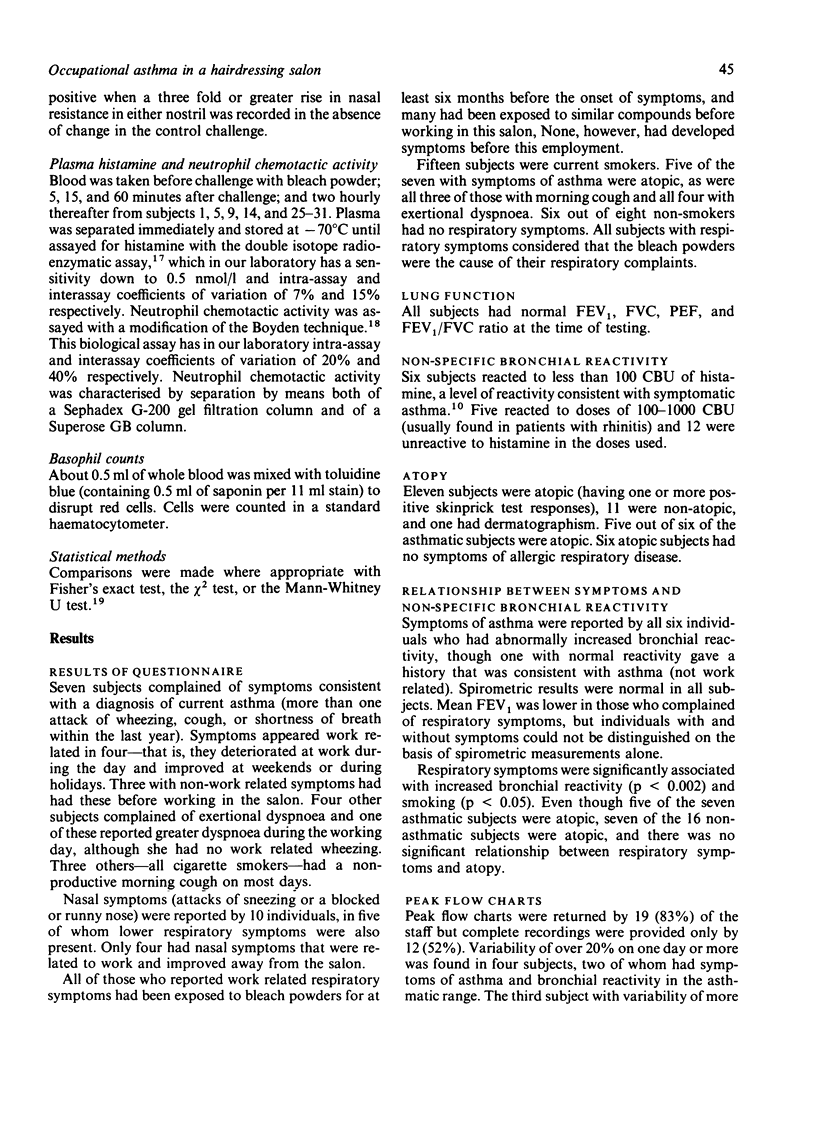
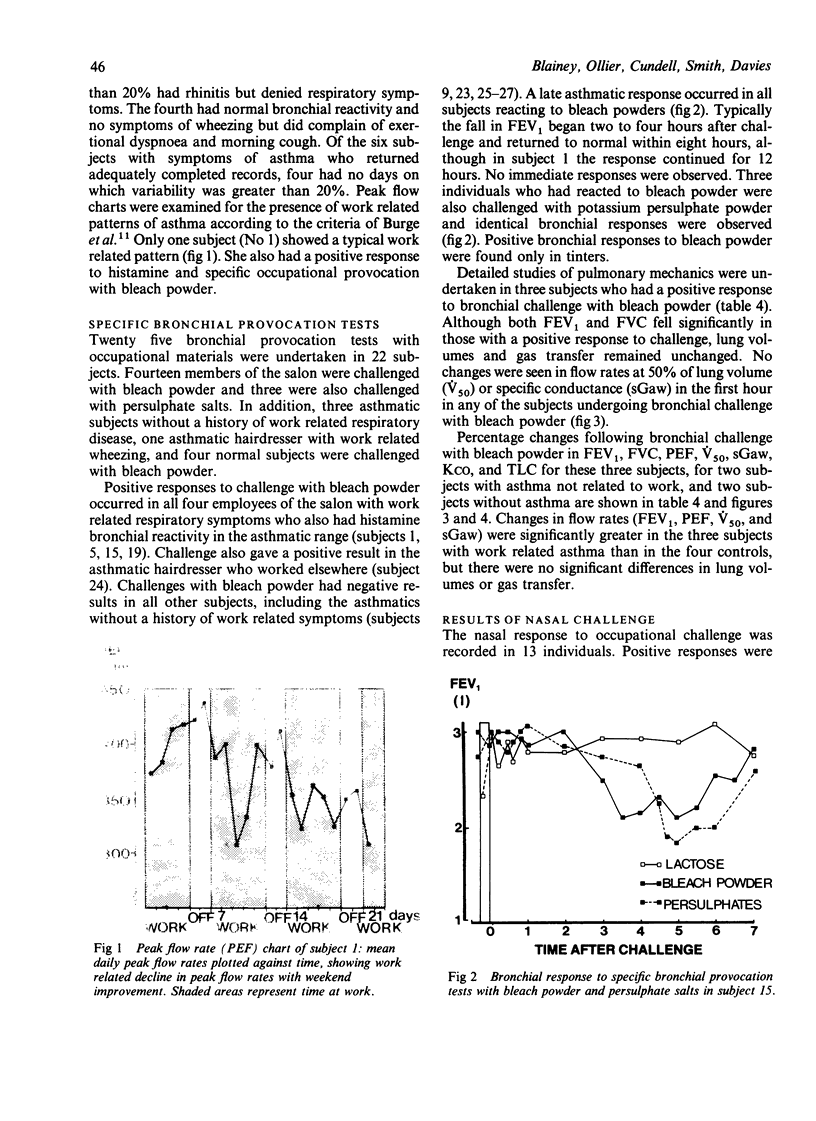



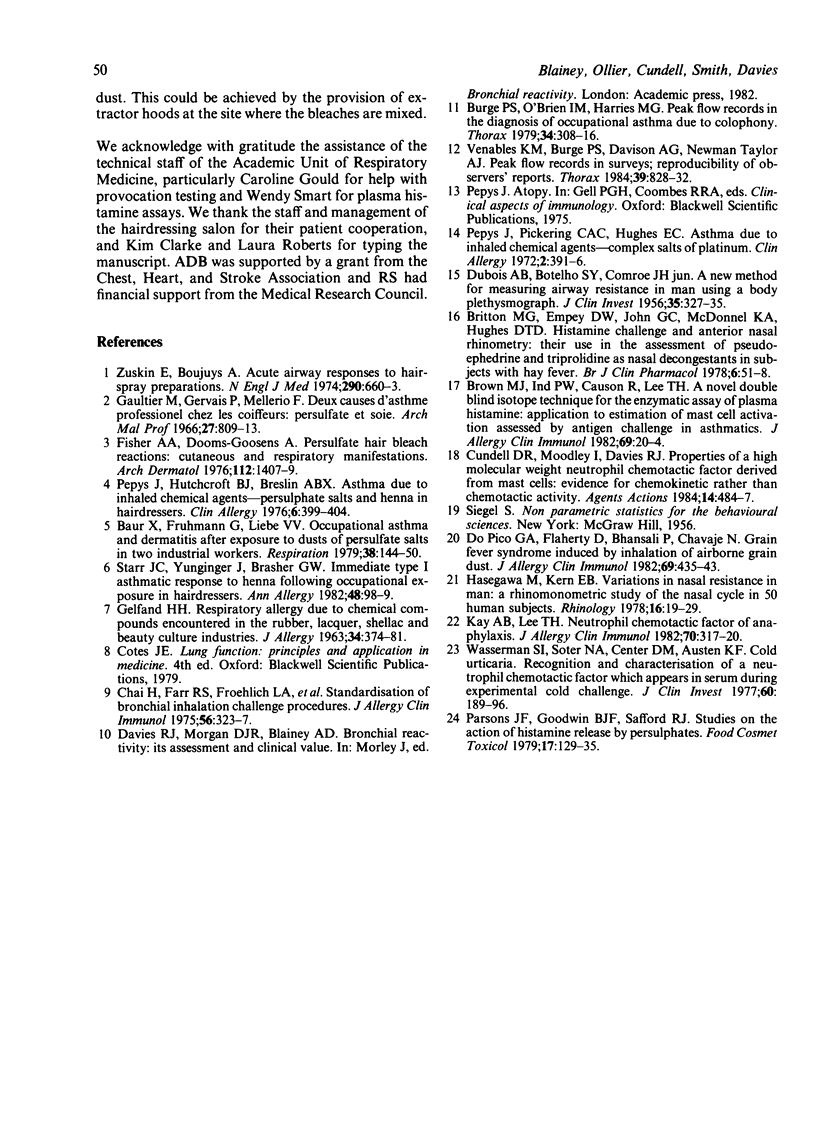
Images in this article
Selected References
These references are in PubMed. This may not be the complete list of references from this article.
- Baur X., Fruhmann G., von Liebe V. Persulfat-Asthma und Persulfat-Dermatitis bei zwei Industriearbeitern. Respiration. 1979;38(3):144–150. doi: 10.1159/000194071. [DOI] [PubMed] [Google Scholar]
- Britton M. G., Empey D. W., John G. C., McDonnell K. A., Hughes D. T. Histamine challenge and anterior nasal rhinometry: their use in the assessment of pseudoephedrine and triprolidine as nasal decongestants in subjects with hayfever. Br J Clin Pharmacol. 1978 Jul;6(1):51–58. doi: 10.1111/j.1365-2125.1978.tb01681.x. [DOI] [PMC free article] [PubMed] [Google Scholar]
- Brown M. J., Ind P. W., Causon R., Lee T. H. A novel double-isotope technique for the enzymatic assay of plasma histamine: application to estimation of mast cell activation assessed by antigen challenge in asthmatics. J Allergy Clin Immunol. 1982 Jan;69(1 Pt 1):20–24. doi: 10.1016/0091-6749(82)90082-3. [DOI] [PubMed] [Google Scholar]
- Burge P. S., O'Brien I. M., Harries M. G. Peak flow rate records in the diagnosis of occupational asthma due to colophony. Thorax. 1979 Jun;34(3):308–316. doi: 10.1136/thx.34.3.308. [DOI] [PMC free article] [PubMed] [Google Scholar]
- Chai H., Farr R. S., Froehlich L. A., Mathison D. A., McLean J. A., Rosenthal R. R., Sheffer A. L., Spector S. L., Townley R. G. Standardization of bronchial inhalation challenge procedures. J Allergy Clin Immunol. 1975 Oct;56(4):323–327. doi: 10.1016/0091-6749(75)90107-4. [DOI] [PubMed] [Google Scholar]
- Cundell D. R., Moodley I., Davies R. J. Properties of a high molecular weight neutrophil chemotactic factor, possibly derived from mast cells: evidence for chemokinetic rather than chemotactic activity. Agents Actions. 1984 Apr;14(3-4):484–487. doi: 10.1007/BF01973855. [DOI] [PubMed] [Google Scholar]
- DUBOIS A. B., BOTELHO S. Y., COMROE J. H., Jr A new method for measuring airway resistance in man using a body plethysmograph: values in normal subjects and in patients with respiratory disease. J Clin Invest. 1956 Mar;35(3):327–335. doi: 10.1172/JCI103282. [DOI] [PMC free article] [PubMed] [Google Scholar]
- Fisher A. A., Dooms-Goossens A. Persulfate hair bleach reactions. Cutaneous and respiratory manifestations. Arch Dermatol. 1976 Oct;112(10):1407–1409. [PubMed] [Google Scholar]
- GELFAND H. H. RESPIRATORY ALLERGY DUE TO CHEMICAL COMPOUNDS ENCOUNTERED IN THE RUBBER, LACQUER, SHELLAC, AND BEAUTY CULTURE INDUSTRIES. J Allergy. 1963 Jul-Aug;34:374–381. doi: 10.1016/0021-8707(63)90056-x. [DOI] [PubMed] [Google Scholar]
- Gaultier M., Gervais P., Mellerio F. Deux causes d'asthme professionnel chez les coiffeurs: persulfate et soie. Arch Mal Prof. 1966 Oct-Nov;27(10):809–813. [PubMed] [Google Scholar]
- Hasegawa M., Kern E. B. Variations in nasal resistance in man: a rhinomanometric study of the nasal cycle in 50 human subjects. Rhinology. 1978 Mar;16(1):19–29. [PubMed] [Google Scholar]
- Kay A. B., Lee T. H. Neutrophil chemotactic factor of anaphylaxis. J Allergy Clin Immunol. 1982 Nov;70(5):317–320. doi: 10.1016/0091-6749(82)90019-7. [DOI] [PubMed] [Google Scholar]
- Parsons J. F., Goodwin B. F., Safford R. J. Studies on the action of histamine release by persulphates. Food Cosmet Toxicol. 1979 Apr;17(2):129–135. doi: 10.1016/0015-6264(79)90210-4. [DOI] [PubMed] [Google Scholar]
- Pepys J., Hutchcroft B. J., Breslin A. B. Asthma due to inhaled chemical agents--persulphate salts and henna in hairdressers. Clin Allergy. 1976 Jul;6(4):399–404. doi: 10.1111/j.1365-2222.1976.tb01922.x. [DOI] [PubMed] [Google Scholar]
- Pepys J., Pickering C. A., Hughes E. G. Asthma due to inhaled chemical agents--complex salts of platinum. Clin Allergy. 1972 Dec;2(4):391–396. doi: 10.1111/j.1365-2222.1972.tb01303.x. [DOI] [PubMed] [Google Scholar]
- Starr J. C., Yunginger J., Brahser G. W. Immediate type I asthmatic response to henna following occupational exposure in hairdressers. Ann Allergy. 1982 Feb;48(2):98–99. [PubMed] [Google Scholar]
- Venables K. M., Burge P. S., Davison A. G., Newman Taylor A. J. Peak flow rate records in surveys: reproducibility of observers' reports. Thorax. 1984 Nov;39(11):828–832. doi: 10.1136/thx.39.11.828. [DOI] [PMC free article] [PubMed] [Google Scholar]
- Wasserman S. I., Soter N. A., Center D. M., Austen K. F. Cold urticaria. Recognition and characterization of a neutrophil chemotactic factor which appears in serum during experimental cold challenge. J Clin Invest. 1977 Jul;60(1):189–196. doi: 10.1172/JCI108756. [DOI] [PMC free article] [PubMed] [Google Scholar]
- Zuskin E., Bouhuys A. Acute airway responses to hair-spray preparations. N Engl J Med. 1974 Mar 21;290(12):660–663. doi: 10.1056/NEJM197403212901205. [DOI] [PubMed] [Google Scholar]
- doPico G. A., Flaherty D., Bhansali P., Chavaje N. Grain fever syndrome induced by inhalation of airborne grain dust. J Allergy Clin Immunol. 1982 May;69(5):435–443. doi: 10.1016/0091-6749(82)90118-x. [DOI] [PubMed] [Google Scholar]



